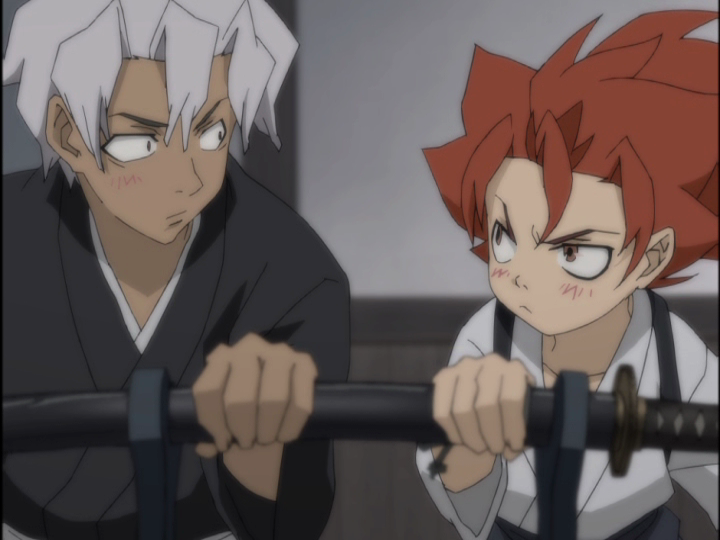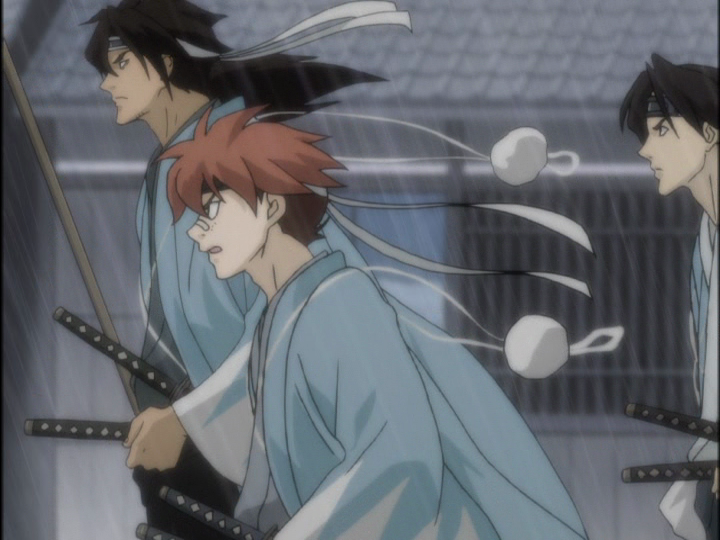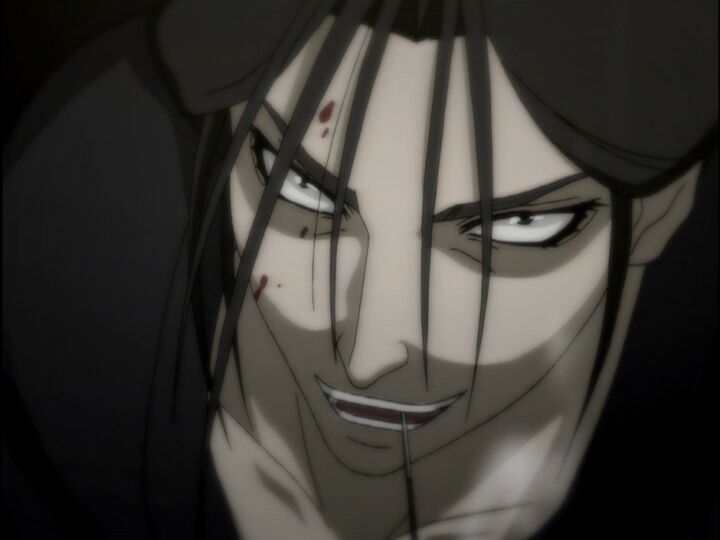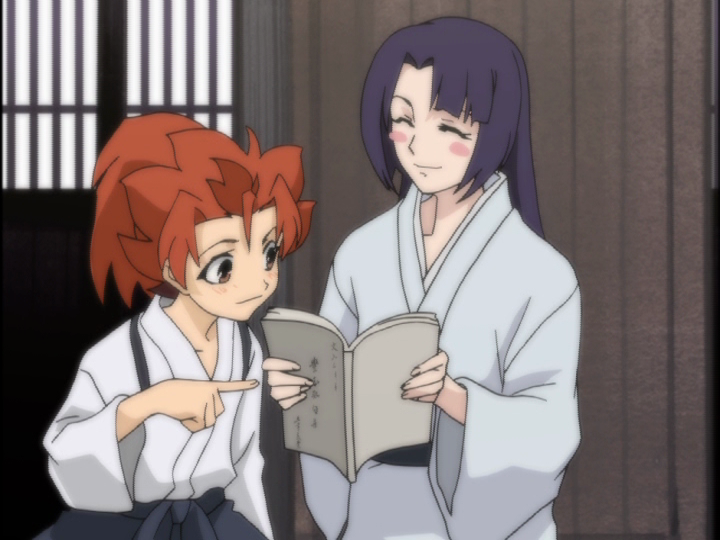Peacemaker Kurogane Review
“The only way you’ll learn here is the way to become a demon.”

Japan, 1864, ten years after the signing of the treaty with America and the old ways are changing. The Shinsengumi (an unofficial police force) support the Tokugawa shogunate in Kyoto – but the rebel Chōshū rōnin are out to cause trouble. Young Tetsunosuke Ichimura and his older brother Tatsunosuke have been orphaned when their parents were brutally murdered. They are taken in by the Shinsengumi, fiery Tetsu as page to strict Vice-Commander Toshizo Hijikata, and mild-mannered Tatsu as a book-keeper. Tetsu, red-haired, feisty and very sensitive about his lack of height, is consumed by the desire to avenge their father’s death, even though his father wanted him to become a peacemaker in his stead. Tetsu (soon nicknamed ‘Puppy Boy’ by the Shinsengumi) has no skills as a page at all; he can’t even make tea. But the people he meets in Kyoto while serving the Shinsengumi will change him forever: sweet-natured Souji Okita who becomes a ravening demon when he draws his blade; kindly Ayumu, cook to the Shinsengumi and her brother Susumu; little Saya, the courtesan’s maid who is mute – and white-haired Suzu, another page boy utterly devoted to his master, sinister Toshimaru Yoshida. A chance encounter with charismatic Ryoma Sakamoto, who has adopted western ways and ideals, hints that there are other, better possibilities for Tetsu other than taking up the sword. But the machinations of the Chōshū rebels means that events in Kyoto are about to career out of control, enmeshing Tetsu and those he has come to love in a twisted web of conspiracies, betrayals and counter-conspiracies from which few will emerge unscathed.

“Yeah! C’mon!” With the aggressive heavy metal challenge of “You Gonna Feel” the OP by HAV, the tone of Peacemaker Kurogane is instantly established. By today’s standards, the story takes its time to unfold, delivering comic domestic scenes around everyday Kyoto and within the Shinsengumi headquarters as cocky little Tetsu and anxious, over-protective big bro Tatsu settle in to their new lives. But this enables us to get to know the cast really well, meaning that when the bloody Ikedaya Inn incident eventually explodes, we genuinely care about those caught up in it. It’s a Shakespearean trick, after all, to place moments of comedy before appalling acts of violence occur, to heighten the impact of the tragedy.

Since Peacemaker Kurogane was first released by ADV in 2005 in the UK, plenty of other anime, otome games and manga have come our way that deal with the now-legendary Shinsengumi and their romantic – but ultimately doomed to failure – idealistic code. But no series quite captures this as effectively (for me) as Nanae Chrono’s manga, brought to life very effectively in this 2003 series. In fact, new sequel films are about to be released in Japan in 2018, starting with Peacemaker Kurogane: Ono-michi (Path of Thoughts) in June, so this re-issue by Anime Limited is timely. A list of ‘Seven Super Shinsengumi Teams’ by Lynzee Loveridge can also be consulted here at ANN!
So why watch Peacemaker Kurogane in 2018? (Did you like Katsugeki Touken Ranbu? This one’s definitely for you!) Even though there’s no getting away from the fact that the animation looks a little dated in places, the characters are sometimes noticeably off-model, and it’s Pillar Boxed*, this is still a very powerful and engaging piece of story-telling. The last episodes (from #18 ‘Rain’ onward) are especially dark, having earned their impact from the slow-burn build to the confrontation at the Ikedaya Inn.

Mangaka Nanae Chrono introduces ninja spies, treacherous nobles and supernatural elements (onmyou) that don’t feel out of place but only add to the growing sense of mystery. Her version of events doesn’t hesitate to show that both sides – true to the practises of the day – resort to violence and torture, when it’s deemed necessary. In this context, Tetsu makes for an interesting choice of viewpoint character as we get to know the Shinsengumi through his eyes. Some may find his brattish behaviour infuriating (although it’s believable, given the traumatic events that have shaped his early life) and others will spot the likeness to other characters making their debuts around 2003: a certain fair-haired young alchemist with a height complex, or a feisty, Hokage wannabe/shinobi-in-training. As for what became of the historical Tetsunosuke…well, the manga is ongoing in Japan (Volume 14 is due out in April 2018).
Keiichi Oku’s soundtrack is weirdly eclectic, ranging from a dramatic sobbing electric guitar melody that captures the heartbreak at the core of the story through effective use of drumming (taiko?) for action scenes to other more bizarre choices (including that old anime composers’ favourite, Offenbach’s ‘Can-can’, which as it dates from 1858 could be described as ‘contemporary’). However, at crucial dramatic moments, director Tomohiro Hirata often chooses silence – or just natural sounds (birdsong, falling rain) which very effectively strengthen the impact on the viewer. In complete contrast, it’s impossible to ignore the swaggering ED “Hey Jimmy” (HAV again) featuring in grainy footage, the show’s mascot, Okita’s bad-tempered little pet pig Saizo, striding out.

The US dub cast features an experienced cast, with Luci Christian (Nami in One Piece) excellent at capturing Tetsu’s inner turmoil and outer brattishness (compare with the VAs for another annoying yet feisty hero in Black Clover …) and delivering a more nuanced performance than Yumiko Kobayashi. But overall, the original Japanese voice actors are hard to beat, with veteran star Jouji Nakata (Alucard in Hellsing, Edmond Dantes in Gankutsuou, ) as Toshizo Hijikata (he’s playing Hijikata again in upcoming anime series Golden Kamuy) and the wonderfully versatile Mitsuki Saiga (Rossiu in Gurren Lagann ) as Souji Okita.
On-disc extras in this 4-disc DVD set from Anime Limited include: Episode commentaries, Character Collections (10 in total), Festival of Gion Video, Original Japanese TV and DVD Spots, Ikedaya Music Clip, Textless Opening & Closing Songs.
A powerful piece of story-telling, Peacemaker Kurogane wears its age well, bringing to life the turbulent times of the Shinsengumi. A series that will appeal to all lovers of samurai and historical tales.
*Pillar Boxed video: When this series was made, it was before 16:9 became the standard for anime. As such it was animated for viewing on older 4:3 ratio televisions. To retain its originally intended video size, black bars will appear at the sides of television screens.


